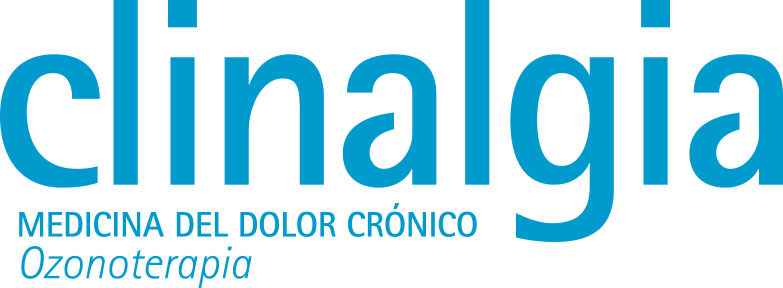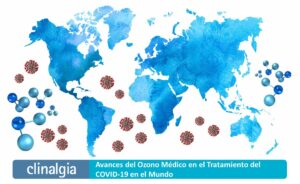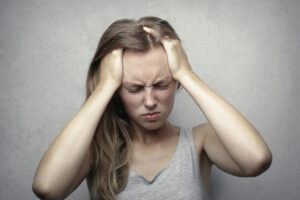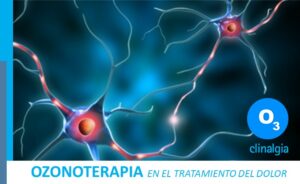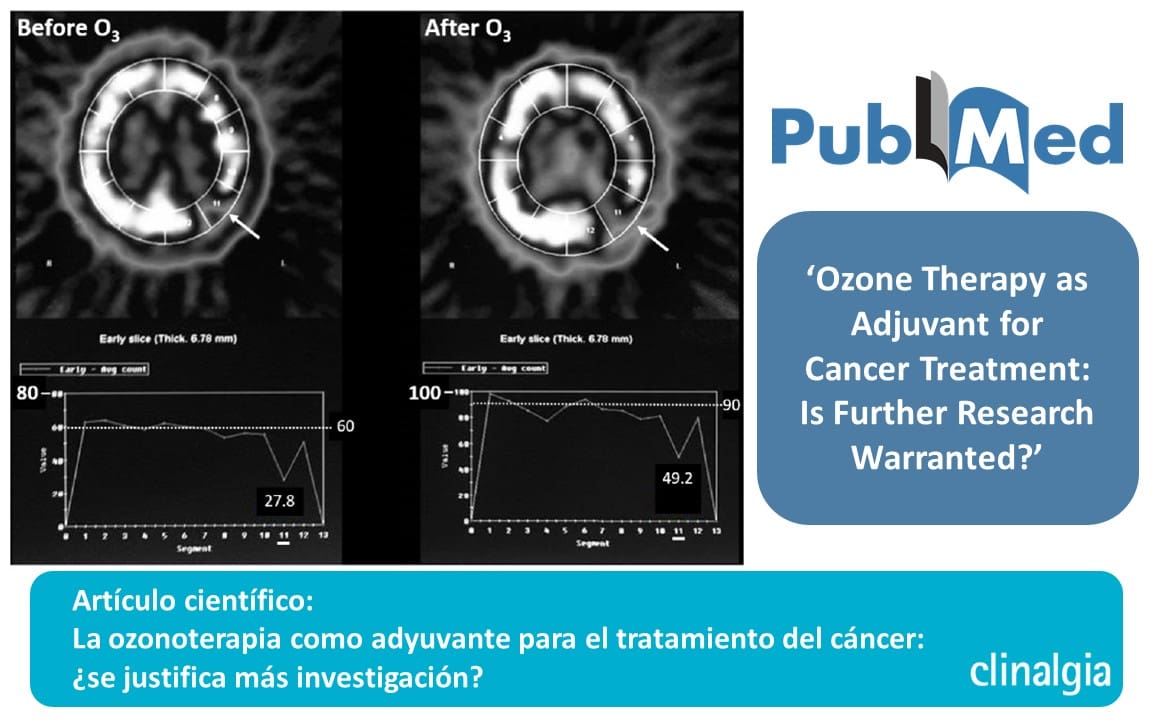
26 Ene La ozonoterapia como adyuvante para el tratamiento del cáncer
Compartimos un artículo publicado en la prestigiosa editorial de Publimed / NIH National Library of Medicine ( National Center for Biotechnology Informatión), que explica las causas del porque la ozonoterapia sistémica es muy recomendable para proteger del daño de la Radioterapia y la Quimioterapia SIN INTERFERIR PARA NADA en el progreso de la enfermedad o eficacia de los tratamientos convencionales. Por eso entendemos que HAY QUE IMPLEMENTAR QUE SE REALICEN ENSAYOS CLINICOS.
Artículo original:
Ozone Therapy as Adjuvant for Cancer Treatment: Is Further Research Warranted?
https://pubmed.ncbi.nlm.nih.gov/30271455/
Traducción:
La ozonoterapia como adyuvante para el tratamiento del cáncer: ¿se justifica más investigación?
Bernardino Clavo 1 2 3 4 5, Norberto Santana-Rodríguez 4 6, Pedro Llontop 7, Dominga Gutiérrez 8, Gerardo Suárez 2, Laura López 2, Gloria Rovira 9, Gregorio Martínez-Sánchez 10, Esteban González 11, Ignacio J Jorge 3, Carmen Perera 12, Jesús Blanco 2, Francisco Rodríguez-Esparragón 1
Resumen
Introducción: este artículo proporciona una descripción general del uso potencial del ozono como adyuvante durante el tratamiento del cáncer.
Métodos: Resumimos los hallazgos de las publicaciones más relevantes enfocadas en este objetivo e incluimos nuestra experiencia clínica relacionada.
Resultados: A lo largo de varias décadas, revistas de prestigio han publicado estudios in vitro sobre la capacidad del ozono para inducir daño directo sobre las células tumorales y, además, potenciar los efectos de la radioterapia y la quimioterapia. Se han demostrado efectos indirectos en modelos animales: modulación inmune por ozono solo y efecto sensibilizador de la radioterapia por administración concurrente de ozono. Los efectos del ozono en la modificación de la curva de disociación de la hemoglobina, los niveles de 2,3-difosfoglicerato, el flujo sanguíneo locorregional y la hipoxia tumoral brindan apoyo adicional para los posibles efectos beneficiosos durante el tratamiento del cáncer. Desafortunadamente, solo se encuentran disponibles unos pocos estudios clínicos. Finalmente, describimos algunos trabajos y nuestra experiencia apoyando el papel potencial de la ozonoterapia local en el tratamiento del retraso en la cicatrización tras la resección del tumor, para evitar retrasos en el inicio de la radioterapia y la quimioterapia.
Conclusiones: Los estudios in vitro y en animales, así como los informes clínicos aislados, sugieren el papel potencial del ozono como adyuvante durante la radioterapia y / o quimioterapia. Sin embargo, se requiere más investigación, como ensayos clínicos aleatorios, para demostrar su utilidad potencial como herramienta terapéutica adyuvante.
FIGURA 1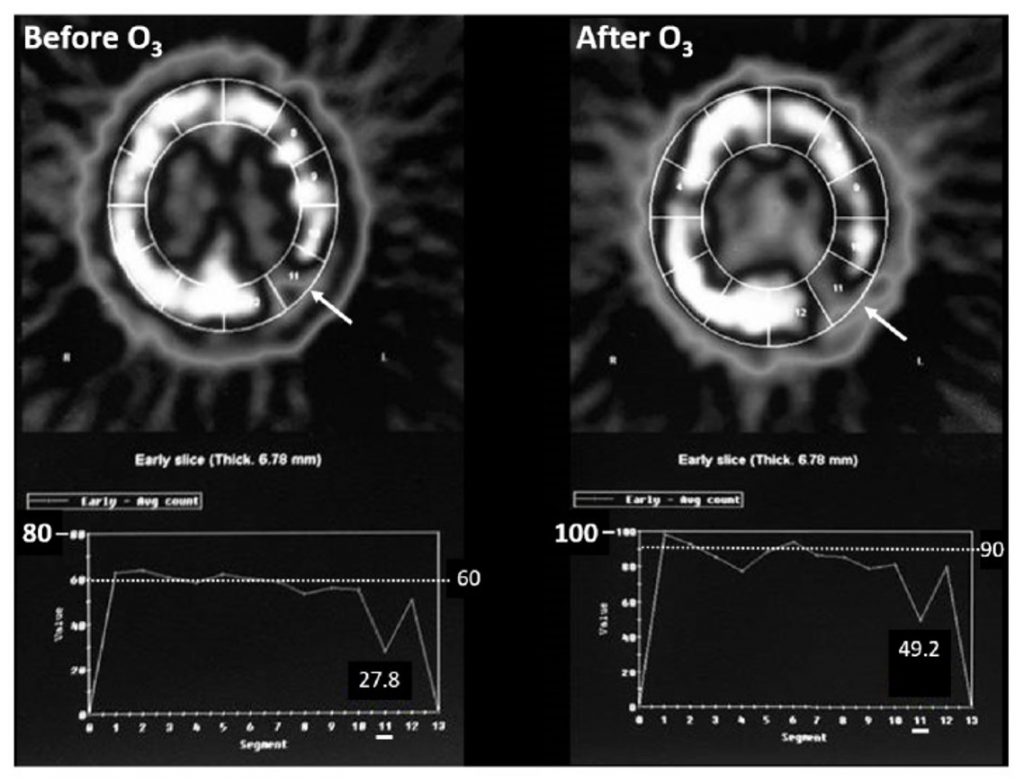 |
| Ozonoterapia y flujo sanguíneo cerebral evaluados por SPECT-ECD. Flujo sanguíneo cerebral evaluado mediante tomografía computarizada por emisión de fotón único (SPECT) con ECD (dímero de cisteinato de etilo 99mTc); el marcador se correlaciona con el flujo sanguíneo cerebral. La figura muestra a un paciente de 68 años con un glioblastoma parietooccipital izquierdo (astrocitoma grado IV) después de una resección subtotal. La SPECT con ECD se realizó antes (izquierda) y después de 3 sesiones de O3T en días alternos (derecha). Después de 3 sesiones de O3T, (1) el índice SPECT general en el cerebro aumentó del 60% al 90% y (2) en el área del tumor (sección # 11) el índice SPECT aumentó del 28% al 49%, aumento> 50% . Tenga en cuenta que hay diferentes escalas antes y después de O3T. |
| FIGURA2
|
| Curación retrasada en pacientes con cáncer. Veintiocho pacientes oncológicos tratados con O3T local por retraso en la cicatrización tras RT (3 pacientes) o tras cirugía (25 pacientes, 7 de los cuales recibieron previamente RT en la misma zona anatómica). La mayoría de los pacientes necesitaban más tratamiento contra el cáncer. El grupo de estudio estuvo formado por 18 mujeres y 10 hombres, con una edad media de 56 ± 16 años (rango: 21-95 años). Las ubicaciones de las heridas fueron 15 (54%) mamas, 6 de cabeza y cuello y 7 en otras áreas. Duración media de la herida: 48 ± 43 días (rango: 10-182 días), área media de la herida: 35,4 ± 64,7 cm2 (rango: 0,6-293 cm2), tiempo de cicatrización: 26 ± 14 días (rango: 4-50 días), sesiones de ozono: 8 ± 4 (rango: 2-18). La O3T local se realizó a una concentración de O3 / O2 entre 50 μg / ml y 20 μg / ml, generalmente en dos sesiones por semana. La reintervención para el cierre de la herida se programó en 19 pacientes, pero se adelantó en 16 de ellos (84%) debido a O3T. El informe preliminar fue presentado en 1999, en el X Congreso de la Sociedad Española de Oncología Radioterápica, y resumía la experiencia colaborativa del Hospital Quirónsalud (Barcelona) y el Hospital Universitario Dr. Negrín (Las Palmas) [20]. Las barras de error muestran medias ± SD. |
| FIGURA 3
|
| Retraso en la cicatrización después de una cirugía pélvica. Paciente de 21 años con linfoma de Hodgkin avanzado y refractario tras varias líneas de TC y RT torácica previa. Unos días después del inicio de la RT pélvica, se suspendió el tratamiento porque la paciente requirió cirugía por apendicitis. (Izquierda) Antes de O3T: retraso de la herida 12 días después de la cirugía y manejo estándar (volumen de 13,5 cc: 60×15 mm por 15 mm de profundidad). Decidimos aplicar O3T local y reiniciar RT. (Derecha) Después de 5 sesiones de O3T durante la 3ª semana de RT. La herida se cerró completamente después de 8 sesiones de O3T en 24 días durante la RT. |
| FIGURA4
|
| Delayed healing after a pancreatic cancer surgery. Fifty-three-year-old female patient with pancreatic carcinoma. During 1st surgery, tumor resection was not possible. She was treated with RT and CT. During a 2nd surgical intervention, complete tumor resection was not possible due to large vessel infiltration, and catheters were inserted for brachytherapy (a localized way for RT administration). (Left) Fourteen days after surgery. Note the catheters for brachytherapy in the lower-right abdomen. At this time, there were 3 wounds indicating delayed healing (arrows), all of which are larger than 40x10x10 mm. Pancreatic cancer cells were confirmed in the wounds. Local O3T was applied together with a 3rd course of RT (2nd external beam RT—this time, with electrons). (Right) Six weeks later. Complete wound healing (despite tumor cells) was observed during the 3rd RT after 15 sessions of local O3T. |
ARTÍCULOS SIMILARES:
-
Antioxidants (Basel). 2019 Nov 26;8(12):588. doi: 10.3390/antiox8120588.PMID: 31779159 Free PMC article. Review.
-
Palliative Treatment of Cancer-Related Pain [Internet].
Oslo, Norway: Knowledge Centre for the Health Services at The Norwegian Institute of Public Health (NIPH); 2005 Dec. Report from Norwegian Knowledge Centre for the Health Services (NOKC) No. 09-2005.PMID: 29320015 Free Books & Documents. Review. -
LHRH agonists for adjuvant therapy of early breast cancer in premenopausal women.
Cochrane Database Syst Rev. 2009 Oct 7;2009(4):CD004562. doi: 10.1002/14651858.CD004562.pub4.PMID: 19821328 Free PMC article. Review. -
Ont Health Technol Assess Ser. 2010;10(23):1-57. Epub 2010 Dec 1.PMID: 23074401 Free PMC article.
-
Ozone Therapy for Tumor Oxygenation: a Pilot Study.
Evid Based Complement Alternat Med. 2004 Jun 1;1(1):93-98. doi: 10.1093/ecam/neh009.PMID: 15257330 Free PMC article.-
Ageing Res Rev. 2020 Nov;63:101138. doi: 10.1016/j.arr.2020.101138. Epub 2020 Aug 15.PMID: 32810649 Free PMC article. Review.
-
Front Oncol. 2020 Apr 28;10:594. doi: 10.3389/fonc.2020.00594. eCollection 2020.PMID: 32411599 Free PMC article.
-
Potential Cytoprotective Activity of Ozone Therapy in SARS-CoV-2/COVID-19.
Antioxidants (Basel). 2020 May 6;9(5):389. doi: 10.3390/antiox9050389.PMID: 32384798 Free PMC article. Review. -
Ozone at low concentrations does not affect motility and proliferation of cancer cells in vitro.
Eur J Histochem. 2020 Apr 2;64(2):3119. doi: 10.4081/ejh.2020.3119.PMID: 32241095 Free PMC article. -
Antioxidants (Basel). 2019 Nov 26;8(12):588. doi: 10.3390/antiox8120588.PMID: 31779159 Free PMC article. Review.
REFERENCIAS
-
- Schwartz-Tapia A., Martínez-Sánchez G., Sabah F. Madrid Declaration on Ozone Therapy., Madrid. Vol. 50. Madrid: ISCO3 (International Scientific Committee of Ozone Therapy); 2015. Madrid Declaration on Ozone Therapy 2015-2020 Eng.
-
- Baeza J., Cabo J. R., Gómez M., et al. WFOTs Review on Evidence Based Ozone Therapy. World Federation of Ozone Therapy. 2015:1–116.
-
- Fetner R. H. Chromosome breakage in Vicia faba by ozone [42] Nature. 1958;181(4607):504–505. doi: 10.1038/181504a0. – DOI
-
- Karlic H., Kucera H., Metka M. Effect of ozone and ionizing radiation on an in vitro model–a pilot study of 4 gynecologic tumors. Strahlenther Onkol. 1987;163:37–42. – PubMed
-
- Cannizzaro A., Verga Falzacappa C., Martinelli M., Misiti S., Brunetti E., Bucci B. O2/3 exposure inhibits cell progression affecting cyclin B1/cdk1 activity in SK-N-SH while induces apoptosis in SK-N-DZ neuroblastoma cells. Journal of Cellular Physiology. 2007;213(1):115–125. doi: 10.1002/jcp.21097. – DOI – PubMed
-
- Simonetti V., Quagliariello V., Giustetto P., Franzini M., Iaffaioli R. V. Association of Ozone with 5-Fluorouracil and Cisplatin in Regulation of Human Colon Cancer Cell Viability: In Vitro Anti-Inflammatory Properties of Ozone in Colon Cancer Cells Exposed to Lipopolysaccharides. Evidence-Based Complementary and Alternative Medicine. 2017;2017:6. doi: 10.1155/2017/7414083.7414083 – DOI – PMC – PubMed
-
- Re L., Malcangi G., Martínez-Sánchez G. Medical ozone is now ready for a scientific challenge: current status and future perspectives. Journal of Experimental and Integrative Medicine. 2012;2:193–196. doi: 10.5455/jeim.070612.ir.012. – DOI
-
- Rovira G., Clavo B., Perez J. L. Ozonoterapia tópica en el tratamiento de los retardos de cicatrización en pacientes oncológicos. Revista de Oncología. 1999;1:45–46.
-
- Menéndez S., Cepero J., Borrego L. Ozone therapy in cancer treatment: State of the art. Ozone: Sciende and Engineering. 2008;30(6):398–404. doi: 10.1080/01919510802473724. – DOI
-
- Rossmann A., Mandic R., Heinis J., et al. Intraperitoneal oxidative stress in rabbits with papillomavirus-associated head and neck cancer induces tumoricidal immune response that is adoptively transferable. Clinical Cancer Research. 2014;20(16):4289–4301. doi: 10.1158/1078-0432.CCR-14-0677. – DOI – PubMed
-
- Bocci V. Ozonetherapy as a possible biological response modifier in cancer. Forsch Komplementarmed. 1998;5:54–60. – PubMed
-
- Bocci V. Ozone A new medical drug. Dordrecht, The Netherlands: Springer; 2005. Autoimmune diseases. Can ozone-therapy do better than antibodies to TNF alpha? pp. 149–162.
-
- Hernuss P., Mueller Tyl E., Seitz W. The radiosensitizing effect of ozone in the animal experiment. Strahlentherapie und Onkologie. 1974;147(1):91–96. – PubMed
-
- Grundner H. G., Bauer E., Tramer G., Utesch E. Animal experimental examinations concerning the application of ozone to non irradiated and to irradiated tumors. I. Intravenous ozone therapy of Crocker sarcoma 180 and of Ehrlich’s carcinoma in the white mouse (German) Strahlentherapie und Onkologie. 1976;151(4):372–381. – PubMed
-
- Grundner H. G., Erler U. Experimentation on animals for investigation of ozone treatment in tumors with and without irradiation. II. Ehrlich ascites carcinoma in vivo. Strahlentherapie und Onkologie. 1976;151(6):522–529. – PubMed
-
- Grundner H. G. Animal experimental examinations concerning the application of ozone to non irradiated and to irradiated tumours. III. Ehrlich ascites cancer cells in vitro. Strahlentherapie und Onkologie. 1976;151(5):480–486. – PubMed
-
- Kiziltan H. S., Bayir A. G., Yucesan G. Medical ozone and radiotherapy in a peritoneal, Erlich-ascites, tumor-cell model. Altern Ther Health Med. 2015;21:24–29. – PubMed
-
- Brizel D. M., Scully S. P., Harrelson J. M., et al. Tumor oxygenation predicts for the likelihood of distant metastases in human soft tissue sarcoma. Cancer Research. 1996;56(5):941–943. – PubMed
-
- Mattassi R., D’Angelo F., Bisetti P. Terapia con ozono per via parenterale nelle arteriopatie obliteranti periferiche: mecanismo biochimico e risultati clinici. Il Giornale Di Chirurgia. 1987;VIII:109–111.
-
- Verrazzo G., Coppola L., Luongo C., et al. Hyperbaric oxygen, oxygen-ozone therapy, and rheologic parameters of blood in patients with peripheral occlusive arterial disease. Undersea & hyperbaric medicine : journal of the Undersea and Hyperbaric Medical Society, Inc. 1995;22(1):17–22. – PubMed
-
- Hernuss P., Müller-Tyl E., Dimopoulos J. Ozone-oxygen injection in gynecological radiotherapy. Strahlentherapie und Onkologie. 1974;148(3):242–245. – PubMed
-
- Muller-Tyl E., Hernuss P., Salzer H. Phospholipids under combined ozone-oxygen administration. Osterr Z Onkol. 1975;2:94–97. – PubMed
-
- Muller-Tyl E., Salzer H., Reisinger L. Ozone-oxygen therapy for gynecologic carcinomas. The effect of parenteral-ozone oxygen mixture administration on free fatty acids and triglycerides in patients with gynecologic carcinomas. Fortschr Med. 1979;97:451–454. – PubMed
-
- Enzelsberger H., Metka M., Salzer H. Effect of a parenteral ozone-oxygen mixture on the concentration of immunoglobulins (IgA, IgG, IgM), of vitamin A and lysozyme activity in patients with cervical cancer. Geburtshilfe und Frauenheilkunde. 1987;47(12):343–345. – PubMed
-
- Parkhisenko I. A., Bil’chenko S. V. The ozone therapy in patients with mechanical jaundice of tumorous genesis. Vestnik khirurgii imeni I. I. Grekova. 2003;162(5):85–87. – PubMed
-
- Borrelli E. Treatment of advanced non-small-cell lung cancer with oxygen ozone therapy and mistletoe: an integrative approach. European Journal of Integrative Medicine. 2012;4:p. 130. doi: 10.1016/j.eujim.2012.07.775. – DOI
-
- Velez-Aguilar M. Terapia adyuvante con ozono en paciente con cáncer de páncreas metastásico. Revista Espa±ola de Ozonoterapia. 2015;5:21–31.
-
- Bocci V., Zanardi I., Pérez Olmedo J. C., Travagli V. A technically feasible treatment for peritoneal carcinomatosis. International Journal of Ozone Therapy. 2012;11(2):85–89.
-
- Stoker G. The surgical uses of ozone. The Lancet. 1916;188(4860):p. 712. doi: 10.1016/S0140-6736(01)31717-8. – DOI
-
- Stoker G. The surgical uses of ozone. The Lancet. 1917;189(4891):p. 797. doi: 10.1016/S0140-6736(01)49000-3. – DOI
-
- Martínez-Sánchez G., Re L., Pérez-Davison G. Las aplicaciones médicas de los aceites ozonizados, actualización. Revista Española de Ozonoterapia. 2012;2:121–139.
-
- Rovira G., Galindo N. La ozonoterapia en el tratamiento de las úlceras crónicas de las extremidades inferiores. Angiologia. 1991;2:47–50. – PubMed
-
- Sánchez G. M., Re L., Perez-Davison G. Las aplicaciones médicas de los aceites ozonizados, actualización. Rev Esp Ozonoterapia. 2012;2:121–139.
-
- Clavo B., SantanaRodriguez N. Are we ready for a medical ozone challenge? Journal of Experimental and Integrative Medicine. 2012;2(3):p. 189. doi: 10.5455/jeim.170612.ed.014. – DOI
-

